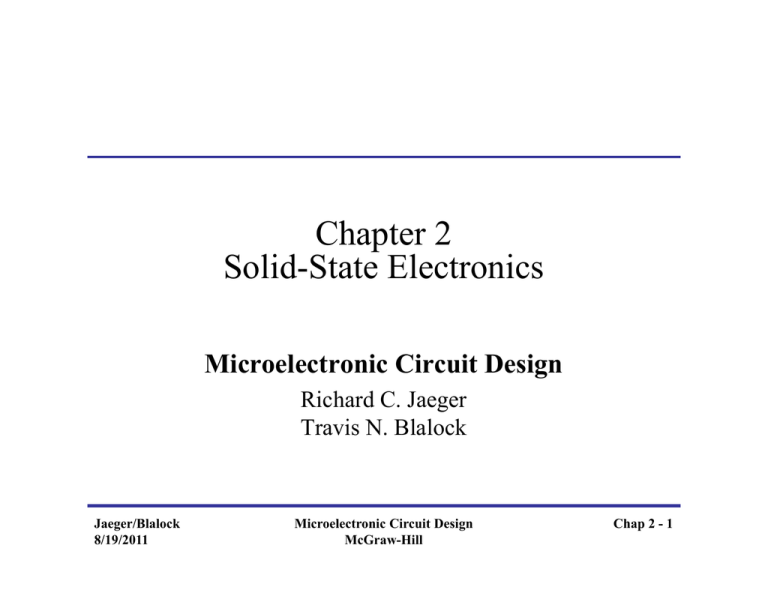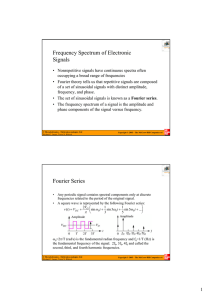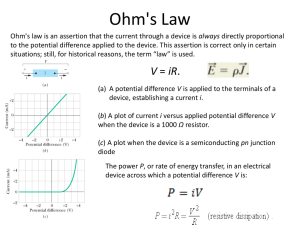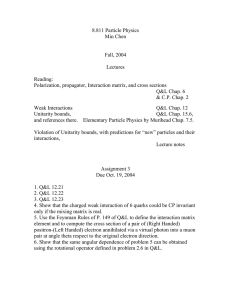Document
advertisement

Chapter 2 Solid-State Electronics Microelectronic Circuit Design Richard C. Jaeger Travis N. Blalock Jaeger/Blalock 8/19/2011 Microelectronic Circuit Design McGraw-Hill Chap 2 - 1 Solid-State Electronic Materials • • • • • Electronic materials fall into three categories: – Insulators Resistivity (ρ) > 105 Ω-cm – Semiconductors 10-3 < ρ < 105 Ω-cm – Conductors ρ < 10-3 Ω-cm Elemental semiconductors are formed from a single type of atom Compound semiconductors are formed from combinations of column III and V elements or columns II and VI. Germanium was used in many early devices. Silicon quickly replaced germanium due to its higher bandgap energy, lower cost, and is easily oxidized to form silicon-dioxide insulating layers. Jaeger/Blalock 8/19/2011 Microelectronic Circuit Design McGraw-Hill Chap 2 - 2 Semiconductor Materials (cont.) Semiconductor Bandgap Energy EG (eV) Carbon (diamond) 5.47 Silicon 1.12 Germanium 0.66 Tin 0.082 Gallium arsenide 1.42 Gallium nitride 3.49 Indium phosphide 1.35 Boron nitride 7.50 Silicon carbide 3.26 Cadmium selenide 1.70 Jaeger/Blalock 8/19/2011 Microelectronic Circuit Design McGraw-Hill Chap 2 - 3 Covalent Bond Model Silicon diamond lattice unit cell. Jaeger/Blalock 8/19/2011 Corner of diamond lattice showing four nearest neighbor bonding. Microelectronic Circuit Design McGraw-Hill View of crystal lattice along a crystallographic axis. Chap 2 - 4 Silicon Covalent Bond Model (cont.) Near absolute zero, all bonds are complete. Each Si atom contributes one electron to each of the four bond pairs. Jaeger/Blalock 8/19/2011 Increasing temperature adds energy to the system and breaks bonds in the lattice, generating electron-hole pairs. Microelectronic Circuit Design McGraw-Hill Chap 2 - 5 Intrinsic Carrier Concentration (ni) • Number of e- (h+) in a semiconductor at a given n i2 • • • • • • ⎛ EG ⎞ -6 cm = BT exp⎜− ⎟ ⎝ kT ⎠ 3 EG = semiconductor bandgap energy in eV (electron volts) k = Boltzmann’s constant, 8.62 x 10-5 eV/K T = absolute termperature, K B = material-dependent parameter, 1.08 x 1031 K-3 cm-6 for Si Bandgap energy is the minimum energy needed to free an electron by breaking a covalent bond in the semiconductor crystal. ni ≈ 1010 cm-3 for Si at room temperature Jaeger/Blalock 8/19/2011 Microelectronic Circuit Design McGraw-Hill Chap 2 - 6 Electron-hole concentrations • A vacancy is left when a covalent bond is broken. • The vacancy is called a hole. • A hole moves when the vacancy is filled by an electron from a nearby broken bond (hole current). • Hole concentration is represented by p. (cm-3) • Electron concentration is represented by n. (cm-3) • For intrinsic silicon, n = ni = p. • The product of electron and hole concentrations is pn = ni2. • The pn product above holds when a semiconductor is in thermal equilibrium (not with an external voltage applied). Jaeger/Blalock 8/19/2011 Microelectronic Circuit Design McGraw-Hill Chap 2 - 7 Drift Current • How can you move a charged particle in a material? • Charged particles move or drift under the influence of the applied field. • The resulting current is called drift current. • Drift current density is j=Qv (C/cm3)(cm/s) = A/cm2 j = current density, (Coulomb charge moving through a unit area) Q = charge density, (Charge in a unit volume) v = velocity of charge in an electric field. Note that “density” may mean area or volumetric density, depending on the context. Jaeger/Blalock 8/19/2011 Microelectronic Circuit Design McGraw-Hill Chap 2 - 8 Mobility • At low fields, carrier drift velocity v (cm/s) is proportional to electric field E (V/cm). The constant of proportionality is the mobility, μ: • vn = - μnE and vp = - μpE , where • vn and vp = electron and hole velocity (cm/s), • μn and μp = electron and hole mobility (cm2/V⋅s) • Hole mobility is less than electron since hole current is the result of multiple covalent bond disruptions, while electrons can move freely about the crystal. Jaeger/Blalock 8/19/2011 Microelectronic Circuit Design McGraw-Hill Chap 2 - 9 Mobility and Resistivity in Doped Semiconductors Note: this figure is slightly different than Figure 2.8 in the textbook. Use Figure 2.8 in the textbook for homework problems. Jaeger/Blalock 8/19/2011 Microelectronic Circuit Design McGraw-Hill Chap 2 - 10 Intrinsic Silicon Resistivity • Given drift current and mobility, we can calculate resistivity: jndrift = Qnvn = (-qn)(- μnE) = qn μnE A/cm2 jpdrift = Qpvp = (-qp)(- μpE) = qp μpE A/cm2 jTdrift = jn + jp = q(n μn + p μp)E = σE This defines electrical conductivity: σ = q(n μn + p μp) (Ω⋅cm)-1 Resistivity ρ is the reciprocal of conductivity: ρ = 1/σ (Ω⋅cm) Jaeger/Blalock 8/19/2011 Microelectronic Circuit Design McGraw-Hill Chap 2 - 11 Semiconductor Doping • Doping is the process of adding very small well controlled amounts of impurities into a semiconductor. • Doping enables the control of the resistivity and other properties over a wide range of values. • For silicon, impurities are from columns III and V of the periodic table. Jaeger/Blalock 8/19/2011 Microelectronic Circuit Design McGraw-Hill Chap 2 - 12 Semiconductor Materials (cont.) Semiconductor Bandgap Energy EG (eV) Carbon (diamond) 5.47 Silicon 1.12 Germanium 0.66 Tin 0.082 Gallium arsenide 1.42 Gallium nitride 3.49 Indium phosphide 1.35 Boron nitride 7.50 Silicon carbide 3.26 Cadmium selenide 1.70 Jaeger/Blalock 8/19/2011 Microelectronic Circuit Design McGraw-Hill Chap 2 - 13 Donor Impurities in Silicon • • • Phosphorous (or other column V element) atom replaces silicon atom in crystal lattice. Since phosphorous has five outer shell electrons, there is now an ‘extra’ electron in the structure. Material is still charge neutral, but very little energy is required to free the electron for conduction since it is not participating in a bond. Jaeger/Blalock 8/19/2011 Microelectronic Circuit Design McGraw-Hill Chap 2 - 14 Acceptor Impurities in Silicon • • • • Boron (column III element) has been added to silicon. There is now an incomplete bond pair, creating a vacancy for an electron. Little energy is required to move a nearby electron into the vacancy. As the ‘hole’ propogates, charge is moved across the silicon. Jaeger/Blalock 8/19/2011 Microelectronic Circuit Design McGraw-Hill Chap 2 - 15 Acceptor Impurities in Silicon (cont.) Hole is propogating through the silicon. Jaeger/Blalock 8/19/2011 Microelectronic Circuit Design McGraw-Hill Chap 2 - 16 Doped Silicon Carrier Concentrations • If n > p, the material is n-type. If p > n, the material is p-type. • The carrier with the largest concentration is the majority carrier, the smaller is the minority carrier. • ND = donor impurity concentration atoms/cm3 NA = acceptor impurity concentration atoms/cm3 • Charge neutrality requires q(ND + p - NA - n) = 0 • It can also be shown that pn = ni2, even for doped semiconductors in thermal equilibrium. Jaeger/Blalock 8/19/2011 Microelectronic Circuit Design McGraw-Hill Chap 2 - 17 Practical Doping Levels • Majority carrier concentrations are established at manufacturing time and are independent of temperature (over practical temp. ranges). • However, minority carrier concentrations are proportional to ni2, a highly temperature dependent term. • For practical doping levels, n ≈ (ND - NA) for n-type and p ≈ (NA - ND) for p-type material. • Typical doping ranges are 1014/cm3 to 1021/cm3. Jaeger/Blalock 8/19/2011 Microelectronic Circuit Design McGraw-Hill Chap 2 - 18 Diffusion Current • In practical semiconductors, it is quite useful to create carrier concentration gradients by varying the dopant concentration and/or the dopant type across a region of semiconductor. • This gives rise to a diffusion current resulting from the natural tendency of carriers to move from high concentration regions to low concentration regions. • Diffusion current is analogous to a gas moving across a room to evenly distribute itself across the volume. Jaeger/Blalock 8/19/2011 Microelectronic Circuit Design McGraw-Hill Chap 2 - 19 Diffusion Current (cont.) • Carriers move toward regions of lower concentration, so diffusion current densities are proportional to the negative of the carrier gradient. j diff p jndiff ∂p ⎛ ∂p ⎞ = ( + q) D p ⎜ − ⎟ = − qD p A/cm 2 ∂x ⎝ ∂x ⎠ ∂n ⎛ ∂n ⎞ = ( − q) Dn ⎜ − ⎟ = + qDn A/cm 2 ∂x ⎝ ∂x ⎠ Diffusion current density equations Jaeger/Blalock 8/19/2011 Microelectronic Circuit Design McGraw-Hill Diffusion currents in the presence of a concentration gradient. Chap 2 - 20 Diffusion Current (cont.) • Dp and Dn are the hole and electron diffusivities with units cm2/s. Diffusivity and mobility are related by Einsteins’s relationship: kT Dp = = = VT = Thermal voltage q μn μp Dn Dn = qVT , Dp = μ p VT • The thermal voltage, VT = kT/q, is approximately 25 mV at room temperature. We will encounter VT throughout this book. Jaeger/Blalock 8/19/2011 Microelectronic Circuit Design McGraw-Hill Chap 2 - 21 Total Current in a Semiconductor • Total current is the sum of drift and diffusion current: ∂n T j n = qμ n nE + qDn ∂x ∂p j Tp = qμ p pE − qD p ∂x Rewriting using Einstein’s relationship (Dp=μnVT), ⎛ 1 ∂n ⎞ T In the following chapters, we will j n = qμ n n⎜ E + VT ⎟ use these equations, combined with ⎝ n ∂x ⎠ ⎛ 1 ∂p ⎞ T j p = qμ p p⎜ E + VT ⎟ p ∂x ⎠ ⎝ Jaeger/Blalock 8/19/2011 Gauss’ law, ∇⋅(εE)=Q, to calculate currents in a variety of semiconductor devices. Microelectronic Circuit Design McGraw-Hill Chap 2 - 22



